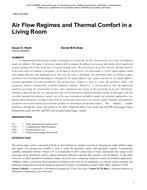A computational fluid dynamics model is developed to examine the air flow characteristics of a room with different supply air diffusers. The paper is devoted to numerically investigate the influence of location and number of air supply and extracts openings on air flow properties in a typical seating room. The work focuses on air flow patterns, thermal behavior in the room where few number of occupants. As an input to the full-scale 3-D room model, a 2-D air supply diffuser model that supplies direction and magnitude of air flow into the room is developed. Air distribution effect on thermal comfort parameters was investigated depending on changing the air supply diffusers type, angels and velocity. Air supply diffusers locations and number were also investigated. The pre-processor Gambit is used to create the geometric model with parametric features. Commercially available simulation software “Fluent 6.3” is incorporated to solve the differential equations governing the conservation of mass, three momentum and energy in the processing of air flow distribution. Turbulence effects of the flow are represented by the well developed two equation turbulence model. In this paper work, the so-called standard k-e turbulence model, one of the most widespread turbulence models for industrial applications, was utilized. Basic parameters included in this work are air dry bulb temperature, air velocity, relative humidity and turbulence parameters are used for numerical predictions of indoor air distribution and thermal comfort. The thermal comfort predictions through this work were based on the PMV (Predicted Mean Vote) model and the PPD (Percentage People Dissatisfied) model, the PMV and PPD were estimated using Fanger’s model.
Citation: ASHRAE Conference Papers, Dallas, TX.
Product Details
- Published:
- 2013
- Number of Pages:
- 8
- File Size:
- 1 file , 1.8 MB
- Product Code(s):
- D-DA-13-C014
